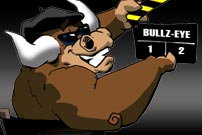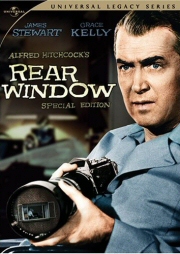 With the temperature dropping, it's time to find someone to keep you warm. Find your hookups with our online dating guide!
With the temperature dropping, it's time to find someone to keep you warm. Find your hookups with our online dating guide!
- Rated PG
- Suspense
- 1954
- Buy the DVD
Reviewed by Bob Westal
()
f the millions of people who saw last year’s featherweight Shia LaBeouf suspense hit “Disturbia,” only a small number will ever realize that what they were viewing was essentially a remake -- a fact which producer Steven Spielberg may eventually end up hearing about in court. Still, film fans should go straight to the source. Director D.J. Caruso’s teen trifle was a Big Mac – and Alfred Hitchcock’s “Rear Window” is an adult-style full course steak dinner from the best restaurant you’ve ever been to.
Simultaneously a devilish entertainment and a big-hearted work of art, my personal all-time favorite film from one of the three or four best directors of all time is as funny as it is suspenseful to the point of being terrifying -- while also managing to be sexy, romantic, and poignant. Both cinematically innovative and perfectly stylish, and with a witty and well-rounded script by John Michael Hayes, this masterpiece of mass entertainment is an abject lesson to makers of modern mainstream thrillers who act as if audiences are capable of precisely two emotions per film
“Rear Window” stars James Stewart as L.B. “Jeff” Jefferies, an adrenaline junkie of a globetrotting photojournalist laid up in his Manhattan apartment with a broken leg. It’s 1955 and television is still a questionable new gadget that a busy guy like Jefferies wouldn’t bother with (and film studios would rather not advertise). Shia LaBouef’s beloved video games and Internet haven’t even been thought of, and household air conditioning is about as common as 65-inch plasmas are today. And there is one of New York’s nasty, muggy heat waves to contend with. The heat turns out to be an extremely dangerous saving grace, because almost everyone in Jefferies’ apartment complex is keeping their windows wide open and providing what amounts to primitive reality television for the frustrated Jefferies. His entertainment choices include: sexy light comedy provided by the lithesome and often under-clad “Miss Torso” (Georgine Darcy); melodramatic pathos from the troubled “Miss Lonelyheart” (Judith Evelyn); and, the closest mid-‘50s equivalent to “Real Sex” -- a mostly unseen honeymoon couple. Still, all of these diversions pale beside the apparent true crime tale concerning the unpleasant salesman (Raymond Burr) with an angry invalid wife, who, heralded only by the sound of a breaking glass and a stifled scream, suddenly disappears.
Even as a temporary invalid himself, Jeff should have other distractions – like a girlfriend, 30 times as lovely as Miss Torso and introduced in one of the most famously provocative kissing scenes in movie history, Lisa Carol Fremont (Grace Kelly). Lisa is so sweet-natured, so unspeakably beautiful, and extraordinarily bright and sophisticated that poor, middle-aged Jefferies is certain that things can’t possibly work out. Of course, he’s behaving like a jerk, and so is he is constantly reminded by Stella (Thelma Ritter) the lovable, tart-tongued nurse provided by the insurance company to take care of him at home. (At times, 1955 seems like a lost utopia.) Still, as the salesmen starts making a number of unexplained trips with his metal suitcase, and a neighborhood dog starts digging at something underneath a flower bed, Jeff slowly persuades both the habitually critical Stella and the correctly aggrieved Lisa that something really is going on, though his policeman former war buddy (Wendell Corey) tries to discourage all this dangerous amateur sleuthing. Maybe the salesman’s wife really did just take a trip to country – though it’s probably Shakespeare’s “undiscovered country,” from which there is no return.
The primary theme here is, of course, voyeurism, but that’s so self evident and so widely commented upon by everyone who has ever discussed “Rear Window” that it hardly seems worth mentioning at this point when, more than ever, voyeurism is a multibillion dollar industry. Besides, Jon Michael Hayes’s sparkling dialogue says most of what needs to be said far better than I could. “We've become a race of Peeping Toms. What people ought to do is get outside their own house and look in for a change,” the crank but smart Stella opines, offering advice that should be presented before every episode of “Big Brother.” In any case, the real statement of any Hitchcock film is never in the words. They are about feelings and ideas that cannot be expressed verbally – though guys like me will never stop trying.
Before “Rear Window,” the great director spent several years trying to see how he could set his films in a constricted space and include plenty of witty dialogue, while still engaging in what he called “pure cinema” (i.e., primarily visual storytelling) in films like the cutting-free “Rope,” the 3-D “Dial M for Murder,” and, most limiting of all, “Life Boat.” In “Rear Window” he at last came up with an ingenious way to have his self-limited cake and eat it too. He shot the film entirely within what is probably the single greatest and most elaborate single set in the history of cinema. Hitchcock, a draftsman and set designer early in his career, devised the set in such a way as to tell both the main story and all the reality-TV/pantomime subplots in an environmentally seamless manner. Still, Hitchcock, always the complete filmmaker, also employed a more realistic type of sound design that made heavy use of environmental sound and “source” music. Eliminating traditional underscoring, Hitchcock chose to make Franz Waxman’s jazz score, as well as such early ‘50s pop hits as “Mona Lisa” and “That’s Amore,” sound as if they’re coming from neighboring radios and phonographs. On the other hand, Hitch was never about realism, and the set is -- obviously and gloriously -- a set, and sound effects are frequently exaggerated for emotional impact. Forever an expressionist and almost never a realist, Hitchcock’s creative choices suggest reality while avoiding any attempt at recreating it.
Much has been written and said about Alfred Hitchcock’s purported neglect of actors. The truth is, that while he was no “actor’s director” in the normal sense, he was also no George Lucas; he nearly always got good performances when he cast performers he respected. In “Rear Window” he has two of the greatest leads in Hollywood history, one of whom he was kind of in love with (it wasn’t Stewart). Grace Kelly gives probably her best performance in a part written especially for her, as a professional fashion maven with a core of iron. James Stewart has no problem holding onto his dignity while performing the entire film in his pajamas, nor does he falter in holding onto our sympathy while being more than a little mean at times to the wonderful Lisa/Grace Kelly. Stewart’s humor and humanity ensure that we always stay on his side and know that, debilitated as he is, we’re not exactly seeing him at his best.
Among the supporting cast, Thelma Ritter gets a lot of the best lines and delivers a great classic-era supporting performance. Her caustic but compassionate middle-aged New York dame might be a mid-century stereotype, but such woman did – and I’m sure still do – walk the streets of New York; Ritter evoked them perfectly. Even Wendell Corey, playing a cop (almost never a very good role in a Hitchcock picture), manages to get a few wry laughs even so. Though he has few fully audible lines, Perry Mason/Ironside to-be Raymond Burr is a perfect combination of fearsome menace and menacing fear as the almost pitiable Lars Thorwald. In an entirely pantomime role, Judith Evelyn is heart-melting as the deeply depressed “Miss Lonelyheart.”
(Trivia buffs take note: A less crucial supporting player I can’t resist mentioning is Ross Bagdasarian, who plays a sad-sack composer trying to complete a new song. Bagdasarian was a musician and composer in real life who wound up making a mint just a few years later when he realized the novelty hit-making potential of sped-up tape, rechristened himself David Seville, and started working with some upstart chipmunks.)
For all the admiration Hitchcock inspires, its fair to say that he can be a rather icy director even in many of his greatest films. Not true here. Along with his personal favorite, 1943’s great “Shadow of a Doubt,” “Rear Window” is, to me, a rich and warmhearted film, even as it goes to some (strictly off-screen) gruesome places almost unheard of in mid-‘50s Hollywood. It’s a combination that works better than you could ever think. As late as the ‘80s, when onscreen mayhem was about as routine as it is now, certain scenes caused actual screams from theater audiences.
Though many critics see “Rear Window” as a deeply cynical work about the innate corruption of the human soul, to me and many others it is a witty and compassionate work that explores and partially forgives human frailty. Even if there is something immoral about peeping into other people’s lives, is it really so terrible if it might also bring a murderer to justice and even settle a romantic quarrel? Curiosity, even (or especially), morbid curiosity about how others live is just a part of being human, and “Rear Window” understands what that means and accepts it. It’s not just one of the best made films of all time, it’s also one of the wisest.
Universal Legacy Series DVD Review:
Another satisfying compilation of previously available and new features from the Universal Legacy series, the extras here are led off by the 2001 hour-long featurette, “Rear Window Ethics” -- an entertaining look at the making of the film, its lasting impact, and it’s much needed restoration. There is also an interview with the under-sung hero of “Rear Window,” writer John Michael Hayes, whose imaginative expansion of a tightly focused story by Cornell Woolrich ranks as one of the great Hollywood screenplays of all time.
New for this DVD, we have a lively commentary from John Falwell, author of the appropriately titled, “Hitchcock's Rear Window: The Well-Made Film,” as well as a pair of very cool, film-geek friendly, short subjects exploring Hithcock’s influential use of editing and sound throughout his career. Featuring interviews with famed directors Martin Scorsese, Guillermo del Toro, John Carpenter and William Friedkin, as well as a number of editorial and sound pros, these are solid offerings that are somewhat hampered by their probably inevitable reliance strictly on clips from films in the Universal and Paramount catalogues – a relative fraction of Hitchcock’s extremely lengthy and successful career. Also included are relevant excerpts from the famed 1967 interviews with auteur and film geek par excellance, François Truffaut, and an episode of “Alfred Hitchcock Presents,” “Mr. Blanchard’s Secret”, directed by Hitchcock. Additionally, there are productions notes, photos and promotional materials, including a trailer narrated by James Stewart for the ‘80s re-release of “Rear Window” alongside several other ‘50s Hitchcock works, which had been all but impossible to see for more than a decade – a painful memory for this writer as a budding Hitchcock fan.
You can follow us on Twitter and Facebook for content updates. Also, sign up for our email list for weekly updates and check us out on Google+ as well.











